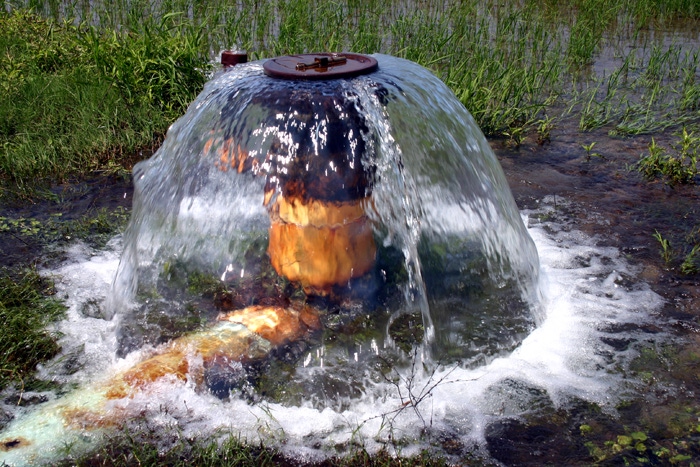June 8, 2011

Rice farmers frustrated with increasing salt water in their irrigation canals filled a meeting hall June 3 to hear what could be done about the problem. Heavy rainfall is the immediate answer, officials said, and long-term solutions will have to be studied.
In 1964 an LSU recommendation determined that 2,400 pounds per acre was the maximum amount of salt that a rice crop could tolerate, said Stuart Gauthier, LSU AgCenter county agent in Vermilion Parish. That threshold covers an entire year, and not just pumping water one time because salt will accumulate in the soil, he said.
The LSU AgCenter can conduct a storm test to determine salt levels before a rice crop is planted. Samples should be taken from several locations throughout a field, and farmers should be aware that salt levels can be redistributed in a field by rainfall, Gauthier said.
The maximum amount of salt in the soil for a rice crop is 750 parts per million, but crawfish can tolerate 8,000 parts per million.
Rice seedlings and flowering rice plants are most vulnerable to salt, he said. Yellowing leaf tips will be the first sign of excessive salt levels, he said. He also recommended monitoring salt levels in irrigation water with a salt meter. The salt level can be documented by county agents from a water sample.
Farmer Donald Sagrera is chairman of the Teche-Vermilion Freshwater District that pumps water from the Atchafalaya Basin into Bayou Vermilion to provide Vermilion Parish rice farmers with a reliable irrigation source. He said the project pumped 138 billion gallons of water last year during 259 days of pumping, enough water to cover 424,000 acres with a foot of water.
In interviews, several farmers described their saltwater problems.
Ronnie “Blue” Zaunbrecher of Lake Arthur said he has no choice but to wait and hope for rain to dilute the saltwater concentration that has moved north from the marsh into his irrigation canal. “Everything is planted. All the inputs are paid for. What’s the alternative?”
He said keeping enough water on the fields is a challenge.
Matthew Zaunbrecher, who farms south of Gueydan, said his rice looks good. “So far, I can’t tell it is affected.” He said the amount of salt in the water has increased weekly by about 10 grains per gallon, and now it is at 92 grains. One grain per gallon equals 14.3 parts per million.
But he said he became more alarmed when low water in an irrigation canal prevented pumping. “No water is worse than salt water.”
Jim Johnson of Jefferson Davis Parish said he had to stop pumping water on approximately 270 acres of rice near Lacassine Bayou south of La. Highway 14. Some of the plants are starting to yellow from the salt exceeding 100 grains per gallon, he said. “It’s going downhill fast.”
Like others at the meeting, Johnson wondered aloud why the Teche-Vermilion project can’t be used to push water to Bayou Nezpique. “We’ve had this problem 12 or 13 years.”
All water control structures to keep salt out of the marshes in southwest Louisiana are working properly, said Robert Morgan of the U.S. Army Corps of Engineers. He said all damage caused by hurricanes Rita and Ike has been repaired.
The Gulf Intracoastal Waterway has too many levee breaks to use it to move fresh water, Morgan said.
Engineer Doug Miller of Sweet Lake Land Co. asked about the possibility of using Catfish and Calcasieu locks to move water and flush salt from the Mermentau River Basin. Morgan said a formal request would have to be made to the Corps for consideration of that idea.
LSU AgCenter rice specialist Johnny Saichuk said he would make the formal request.
Saichuk also advised farmers that without heavy rain, they will be facing difficult choices. “You are in a real bind. Pick the best fields and try to save something.”
Farmers should consult crop insurance agents before making any decisions to stop pumping, he said. Some rice being irrigated with salty water will start dying in a couple of weeks.
Nathan Crisp of the U.S. Department of Agriculture said the drought facing Louisiana has caused cattle producers to sell off herds because they can’t afford to buy hay, and pastures are drying up. He encouraged farmers to report accurate crop information to establish average yields and planting data for setting insurance rates and compensation.
You May Also Like




